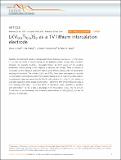Files in this item
Li(V0.5Ti0.5)S2 as a 1V lithium intercalation electrode
Item metadata
| dc.contributor.author | Clark, Steve J. | |
| dc.contributor.author | Wang, Da | |
| dc.contributor.author | Armstrong, A. Robert | |
| dc.contributor.author | Bruce, Peter G. | |
| dc.date.accessioned | 2016-04-11T10:30:05Z | |
| dc.date.available | 2016-04-11T10:30:05Z | |
| dc.date.issued | 2016-03-21 | |
| dc.identifier | 241881287 | |
| dc.identifier | f028d559-fbff-406e-be9e-d5ce4e44177e | |
| dc.identifier | 84961830100 | |
| dc.identifier | 000372461800001 | |
| dc.identifier.citation | Clark , S J , Wang , D , Armstrong , A R & Bruce , P G 2016 , ' Li(V 0.5 Ti 0.5 )S 2 as a 1V lithium intercalation electrode ' , Nature Communications , vol. 7 , 10898 , pp. 1-7 . https://doi.org/10.1038/ncomms10898 | en |
| dc.identifier.issn | 2041-1723 | |
| dc.identifier.other | Bibtex: urn:dbd56f15444476d6b9759975ae2fff5b | |
| dc.identifier.other | ORCID: /0000-0003-1937-0936/work/28123628 | |
| dc.identifier.uri | https://hdl.handle.net/10023/8592 | |
| dc.description | P.G.B. is indebted to the EPSRC including the SUPERGEN program for financial support. | en |
| dc.description.abstract | Graphite, the dominant anode in rechargeable lithium batteries, operates at ~0.1V versus Li+/Li and can result in lithium plating on the graphite surface, raising safety concerns. Titanates, for example, Li4Ti5O12, intercalate lithium at ~1.6 V versus Li+/Li, avoiding problematic lithium plating at the expense of reduced cell voltage. There is interest in 1V anodes, as this voltage is sufficiently high to avoid lithium plating while not significantly reducing cell potential. The sulfides, LiVS2 and LiTiS2, have been investigated as possible 1V intercalation electrodes but suffer from capacity fading, large 1st cycle irreversible capacity or polarization. Here we report that the 50/50 solid solution, Li1+x(V0.5Ti0.5)S2, delivers a reversible capacity to store charge of 220 mAhg-1 (at 0.9 V), 99% of theoretical, at a rate of C/2, retaining 205 mAhg-1 at C-rate (92% of theoretical). Rate capability is excellent with 200 mAhg-1 at 3C. C-rate is discharge in 1 h. Polarization is low, 100mV at C/2. To the best of our knowledge, the properties/performances of Li(V0.5Ti0.5)S2 exceed all previous 1V electrodes. | |
| dc.format.extent | 7 | |
| dc.format.extent | 1165781 | |
| dc.language.iso | eng | |
| dc.relation.ispartof | Nature Communications | en |
| dc.subject | QD Chemistry | en |
| dc.subject | NDAS | en |
| dc.subject | BDC | en |
| dc.subject | R2C | en |
| dc.subject.lcc | QD | en |
| dc.title | Li(V0.5Ti0.5)S2 as a 1V lithium intercalation electrode | en |
| dc.type | Journal article | en |
| dc.contributor.sponsor | EPSRC | en |
| dc.contributor.institution | University of St Andrews. School of Chemistry | en |
| dc.identifier.doi | https://doi.org/10.1038/ncomms10898 | |
| dc.description.status | Peer reviewed | en |
| dc.identifier.grantnumber | EP/I029273/1 | en |
This item appears in the following Collection(s)
Items in the St Andrews Research Repository are protected by copyright, with all rights reserved, unless otherwise indicated.

